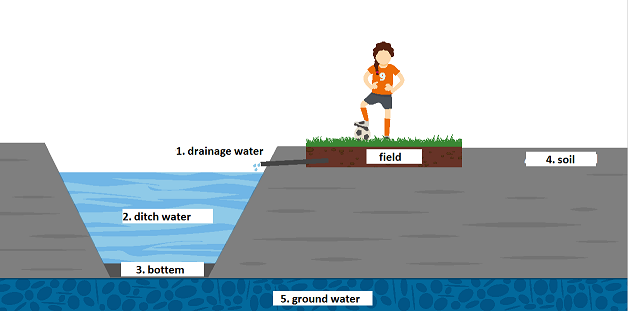RIVM conducted an exploratory study on the environmental impact of rubber granulate on synthetic turf pitches. The results of the exploratory study indicate that the use of rubber granulate on synthetic turf pitches can be harmful to the environment in the close vicinity of these pitches:
Image 1: Cross section of synthetic turf field water drainage and environment
- Substances from the rubber granulate can leach into the ground around the pitches (the soil borders) and into the subsoil and drainage water.
- These substances are bad for the ecosystem because they detrimentally affect biodiversity.
- Children at play, pets and cattle that accidentally ingest soil from the borders are not at risk.
- Ditch water and groundwater in the natural subsoil are not contaminated by the rubber granulate on the pitches. This water is expected to be sufficiently suitable for use, for example for spraying vegetable gardens.
Background
At the end of 2017, RIVM was commissioned by the Ministry of Infrastructure and Water Management to conduct this study. The study was prompted by the discovery in 2017 that large quantities of rubber granulate were vanishing from the pitches into the environment. RIVM had previously identified potential environmental risks from substances leaching out of the rubber granulate.
Aim
The aim of the study was to explore the extent to which the area surrounding synthetic turf pitches is affected by rubber granulate made from old tyres, and by the substances found in that rubber granulate. Moreover, the study aimed to determine whether there was any impact on the ecosystem and on humans in relation to any indirect exposure. The study focused on water and on the soil.
Research questions
Five research questions were explored:
- What concentrations of rubber granulate particles can be found in the soil and water surrounding synthetic turf pitches?
- To what extent do substances originating from rubber granulate occur in water, groundwater, soil and sediments in the area around synthetic turf pitches?
- Are there any risks to living organisms in the soil and water?
- Are there any risks to people resulting from consumption of fruit and vegetables grown in local gardens that are sprayed with ditch water in the area around synthetic turf pitches, or resulting from other environmental exposure routes?
- Are there any risks to other animals than living organisms in the soil and water, such as birds, cattle and pets?
Structure of the study
The exploratory study consisted of various components:
- Fieldwork to take samples around 10 synthetic turf pitches with rubber granulate infill. We compared the substance concentrations found in those samples to the concentrations of the same substances in samples taken around real grass pitches. The concentrations were also compared to environmental quality standards.
- The chemical analyses were conducted by accredited research and analysis laboratories (Synlab, the Netherlands Organisation for Applied Scientific Research (TNO), and Aquon).
- The results from reports by municipal authorities and water boards that had commissioned local inspections of sports pitches were also included in the study.
- The Foundation for Applied Water Research STOWA conducted a parallel study on the effects of substances on organisms in water and sediment.
- In the course of this study, we solicited advice from a stakeholders feedback group and a scientific-sounding board group.
- The knowledge obtained from these sources was combined in this report.
Recommendations
In order to protect the environment, RIVM recommends taking steps to prevent rubber granulate from ending up in the soil borders and to prevent substances leaching into ditches via drainage water.
Restriction dossier for PAHs in rubber granulate
This exploratory environmental impact study followed from the 2016 RIVM study focusing exclusively on athletes’ health. Another activity following from the 2016 study was the preparation of a REACH restriction dossier: a proposal under EU (European Union) law for establishing safe limits for PAH concentrations based on health impact assessment. Depending on the available information on the environmental impact, for instance the data generated by this environmental impact study, additional measures may be instituted. Updated limits would provide guidelines for e.g. the producers of the rubber granulate, the suppliers of the infill, and the owners of the synthetic turf pitches, making it possible to guarantee the safety of playing sports on synthetic turf pitches with rubber granulate infill. The proposal will be submitted to the European Union this summer.
